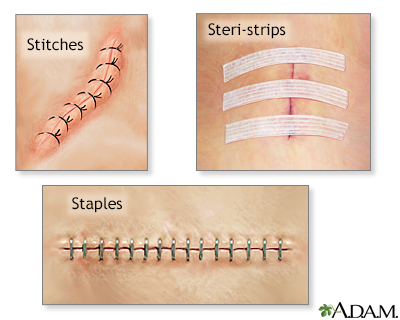Laceration - sutures or staples - at home

An incision may be closed with. 1. Sutures, stitches, on the outside of the body. 2. Surgical staples, which provide added strength to the incision. 3. Sutures on the inside, underneath the skin. Small sticky strips, called Steri-strips, may be placed on your skin across the incision line. These strips will fall off when the incision has healed.
How to Care for Stitches (Sutures)
- Keep the area clean and dry for the first 24 to 48 hours after stitches have been placed.
- Then, you can start to gently wash around the site 1 to 2 times daily. Wash with cool water and soap. Clean as close to the stitches as you can. Do not wash or rub the stitches directly.
- Dab the site dry with a clean towel. Do not rub the area. Avoid using the towel directly on the stitches.
- If there was a bandage over the stitches, replace it with a new clean bandage and any treatment as directed by your provider.
- Your provider should also tell you when you need to have a wound checked and the stitches removed. If not, contact your provider for an appointment.
How to Care for Staples
Medical staples are made of special metal and are not the same as office staples. Care for your staples and wound as follows:
- Keep the area completely dry for 24 to 48 hours after staples are placed.
- Then, you can start to gently wash around the staple site 1 to 2 times daily. Wash with cool water and soap. Clean as close to the staples as you can. Do not wash or rub the staples directly.
- Dab the site dry with a clean towel. Do not rub the area. Avoid using the towel directly on the staples.
- If there was a bandage over the staples, replace it with a new clean bandage and any treatment as directed by your provider.
- Your provider should also tell you when you need to have a wound check and the staples removed. If not, contact your provider for an appointment.
Important Tips
Keep the following in mind:
- Prevent the wound from reopening by keeping activity to a minimum.
- Make sure your hands are clean when you care for the wound.
- If the laceration is on your scalp, it is OK to shampoo and wash. Be gentle and avoid excessive exposure to water.
- Take proper care of your wound to help reduce scarring.
- Contact your provider if you have questions or concerns about how to care for stitches or staples at home.
- You can take pain medicine, such as acetaminophen, as directed for pain at the wound site.
- Follow-up with your provider to make sure the wound is healing properly.
When to Call the Doctor
Contact your provider right away if:
- There is any redness, pain, or yellow pus around the injury. This could mean there is an infection.
- There is bleeding at the injury site that does not stop after 10 minutes of direct pressure.
- You have new numbness or tingling around the wound area or beyond it.
- You have a fever of 100°F (37.7°C) or higher.
- There is pain at the site that does not go away, even after taking pain medicine.
- The wound has split open.
- Your stitches or staples have come out too soon.
References
Beard JM, Osborn J. Common office procedures. In: Rakel RE, Rakel DP, eds. Textbook of Family Medicine. 9th ed. Philadelphia, PA: Elsevier Saunders; 2016:chap 28.
Lammers RL, Scrimshaw LE. Methods of wound closure: In: Roberts JR, Custalow CB, Thomsen TW, eds. Roberts and Hedges' Clinical Procedures in Emergency Medicine and Acute Care. 7th ed. Philadelphia, PA: Elsevier; 2019:chap 35.
Simon BC, Hern HG. Wound management principles. In: Walls RM, ed. Rosen's Emergency Medicine: Concepts and Clinical Practice. 10th ed. Philadelphia, PA: Elsevier; 2023:chap 50.
Version Info
Last reviewed on: 1/30/2024
Reviewed by: Jesse Borke, MD, CPE, FAAEM, FACEP, Attending Physician at Kaiser Permanente, Orange County, CA. Also reviewed by David C. Dugdale, MD, Medical Director, Brenda Conaway, Editorial Director, and the A.D.A.M. Editorial team.


